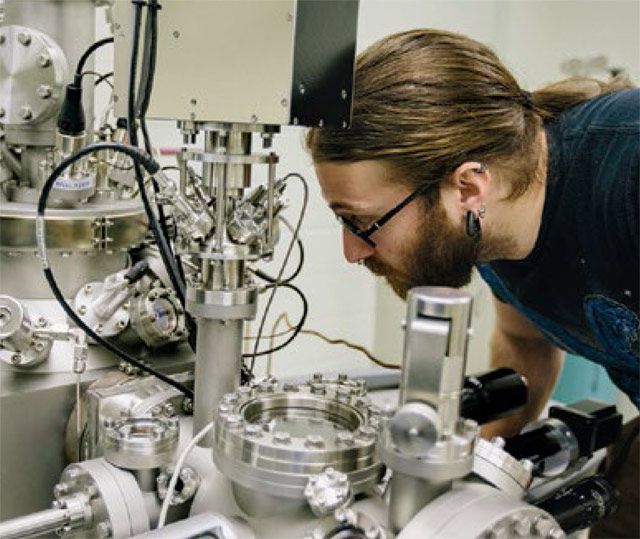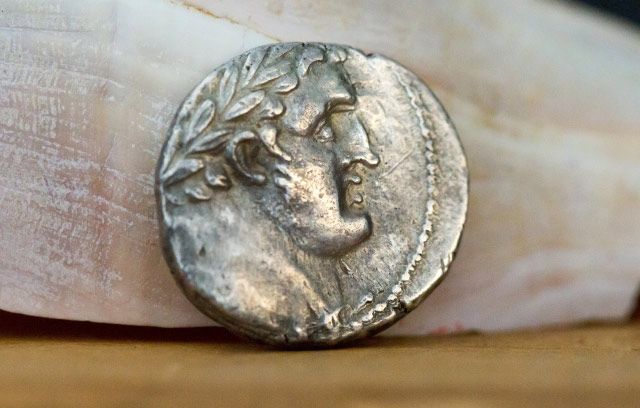Using the most advanced techniques for analyzing the surfaces of materials, a team of researchers has shed light on the coin-making practices of the Roman Empire and the manner in which Roman coins have corroded over the past 2,000 years.
The study by Lehigh chemical engineers and materials scientists demonstrated that low-energy ions, x-rays and laser lights can be used to analyze archaeological objects without damaging them. And it yielded clues about the environment to which the coins, and the people who handled them, were exposed.
The group, which studied five Roman coins, reported its findings in the journal Applied Surface Science in an article titled “Analysis of corrosion layers in ancient Roman silver coins with high resolution surface spectroscopic techniques.”
The paper’s authors included Israel E. Wachs, the G. Whitney Snyder Professor of chemical and biomolecular engineering, and Michael R. Notis, professor emeritus of materials science and engineering. The lead author, Christopher J. Keturakis, earned a Ph.D. in chemical engineering from Lehigh in 2015.
The researchers used three surface spectroscopic techniques to determine the composition of the highly reactive outer layers of the coins, where corrosion occurs. One of these, high sensitivity-low energy ion scattering (HS-LEIS) spectroscopy, had not previously been used to study archaeological specimens.
HS-LEIS, said Wachs, is the only characterization technique that can determine the elemental composition of the outermost layer of atoms on the surface of a material. This layer measures roughly 0.3 nanometer (1 nm is a billionth of a meter) in width. HS-LEIS had previously been considered a destructive investigative method but the researchers found it could be rendered “virtually nondestructive” with the utilization of modern high sensitivity analyzers that collect data approximately 3,000 times faster.
Lehigh’s HS-LEIS instrument is one of two of its kind in the United States and only 10 in the world.
The researchers found potassium, sodium, chlorine and sulfur to be “key corrosion components” for all five coins, with sulfur concentrated near the surface and chlorine occurring at greater depths.
The absence or presence of elements, said Wachs, reflects the “corrosion environments” from the coins’ contact with humans, shells, sand, pottery, wood and other sources. This elemental information, he added, cannot be used to infer significance because of the coins’ unknown handling history.
The researchers also found that some of the coins contained lead, resulting from the coin production process, at the surface layer. Wachs said this means that the people who handled the coins in ancient times were directly exposed to lead, a potent neurotoxin.
The oldest coins, which dated from 225 to 214 B.C.E. (Before Common Era, formerly B.C.), contained copper oxide, sodium, aluminum and lead on their outermost surface layer, while the more recent coins, dating from 98 to 244 C.E. (Common Era, formerly A.D.), contained copper oxide, silver, nitrogen, fluorine, sodium, aluminum, sulfur and chlorine. All the coins contained adsorbed hydrocarbons on their surfaces.
“The ability to identify the elements on metal surfaces,” Wachs said, “yields clues about the environment to which the metal was exposed, and to which people living at that time were exposed.
“Metal surfaces are very reactive with gases and vapors that are present in only trace amounts in the air,” said Wachs. “If you want to find out what’s in the air, just take a clean metal and expose it to the air. Whatever is in the air—oxygen, nitrogen, chlorine, sulfur, hydrocarbons—will concentrate on the surface of the metal.”
The sodium found on the surfaces of the coins, Wachs added, likely came from the sweat of the people who handled them.
A declining empire’s declining coin values
The new surface investigation built on several earlier Lehigh studies of the bulk composition of ancient artifacts, starting with a study of Roman coins published in 1992 in the journal Materials Characterization by Alan W. Pense, former Lehigh provost and professor of materials science and engineering.
In an article titled “The Decline and Fall of the Roman Denarius,” Pense showed it was possible to use optical microscopy and metallography to examine the microstructures of coins and determine the overall amounts of the various metals they contain. Two of the coins Pense examined were also analyzed in the new study.
“Pense showed that if you knew the microstructures of the various alloys, and if you used bulk phase diagrams, you could calculate the amount of total silver in each coin,” said Notis. “He showed that our assumptions about Roman history were correct—that the decline of the Roman Empire was reflected in the decline in the value of its coinage.
“During the early Roman Republic, coins were made of almost 100-percent silver. But the silver content declined gradually and then more precipitously during the Roman Wars, roughly during the 40s B.C.E., until Augustus Caesar took control [in 27 B.C.E.], stabilized the empire and decreed that Roman coinage had to contain a certain quantity of silver. For a long period of time, the silver content of coins stayed the same until the empire began to fall apart and the silver content fell off the chart.”
Several years later, Notis teamed with Aaron Shugar, a former postdoctoral researcher at Lehigh, and two other scientists in a study of 700 shekel and half-shekel coins that were minted in the ancient Roman city of Tyre (located in modern-day Lebanon) and recovered half a century ago in Israel.
The researchers used a handheld X-ray fluorescence (XRF) unit, irradiating the coin with an X-ray and measuring the rays reflected back to determine the coins’ overall composition. They confirmed the XRF results with electron probe bulk microanalysis.
The Tyrian shekels, Notis said, circulated during the time of Jesus, when the temple in Jerusalem was the central meeting place for Jews living in the Roman Empire. “Every year, Jews were required to pay a tax to the temple,” he said. “The temple accepted only coins minted in the town of Tyre, which was known for the purity of its silver.
“We wondered what had happened to the silver content of the coinage. Two main hoards of coins from Tyre have been found. One was near Haifa in the village of Isfiya, the other was near Qumran, adjacent to the site where the Dead Sea Scrolls were discovered.” Several jars of Roman coins in mint condition, similar to the coins investigated in the Lehigh studies, were also found with the Dead Sea Scrolls.
The XRF analysis, said Notis, revealed the overall silver content of each Tyrian coin in two minutes. “We analyzed 700 coins in 24 hours using a handheld XRF unit. We plotted the bulk silver content versus the year of the date of the coin on a graph.
“We found much the same results that Pense had found—coins were made of 90-plus percent bulk silver until 44 B.C.E. when the Roman civil wars began. All of a sudden, the silver content dropped dramatically until Augustus Caesar took over.”
Notis and Shugar also used XRF to examine coins minted by the Philistines between 500 and 400 B.C.E.
“We were able to spot fakes immediately,” said Notis, “because they had a silver content of only 46 percent, compared to the 95 percent silver content of the authentic coins.”
A new window on environmental history
The five coins analyzed with surface spectroscopy by the current research team were minted roughly between 225 B.C.E. and 244 C.E. Their location of origin is not known and the coins, being common and in poor condition, are judged to have little value for collectors.
The researchers found that the oldest coin, a Jupiter-Quadriga minted between 225 and 214 B.C.E., had an overall silver content of 97 to 99 percent by weight. The bulk silver contents of the other coins were 85 percent for a Trajan coin minted between 98 and 117 C.E., 55-60 percent for a Caracalla (198 to 217 C.E.), and 45 percent for a Gordian III (225 to 244 C.E.).
The group also studied a coin minted in 5 or 6 C.E. in Tyre. Its bulk silver content was 97 to 99 percent.
Silver is naturally malleable but can be strengthened if it is alloyed with small amounts of copper. The addition of copper, however, can have a significant effect on the formation of corrosion layers in silver, the researchers found in their study.
The group also found that copper segregated to the surface of the coins to form copper oxide (cuprous oxide, Cu2O), which created a protective skin over the silver coins independent of the overall copper content. The silver, meanwhile, most likely reacted with environmental gases and vapors to form silver sulfide (Ag2S), silver chloride (AgCl) and silver oxide (silver monoxide, Ag2O). Similar copper phases are probably also present, Wachs said.
In addition to HS-LEIS, the group employed high-resolution X-ray photoelectron spectroscopy (HR-XPS), using Lehigh’s Scienta ESCA-300 HR-XPS spectrometer, the only one of its kind in North America. The researchers also used Lehigh’s high-resolution dispersive Raman spectrometer to collect surface enhanced Raman spectra (SERS).
HS-LEIS is well-suited for the study of ancient coins, said Wachs, who directs Lehigh’s Operando Molecular Spectroscopy and Catalysis Research Lab.
“LEIS is the only technique that can identify the composition of atoms on the outermost layer of a solid surface,” said Wachs. “It enabled us to do a very detailed corrosion analysis and determine the atomic composition layer by layer of the surface region of the coins.”
Wachs said the Lehigh group was the first in the world to apply HS-LEIS to examine archaeological objects.
“LEIS has typically been considered a destructive technique because analysis involves scattering ions from surfaces,” the researchers wrote in Applied Surface Science. “However, the new HS-LEIS spectrometer utilizes high sensitivity toroidal analyzers that require about 3,000 times fewer ion-surface collisions [and] interactions to collect the LEIS signals, which renders sampling virtually non-destructive.”
The Scienta ESCA-300, one of the most powerful instruments of its kind in the world, enabled the group to determine the surface composition and oxidation states of the coin surfaces. Complementary surface-enhanced Raman spectroscopy yielded molecular details about the surface region of the coin components.
“Raman gives vibrational information at the molecular level,” said Wachs. “We were able to distinguish between silver oxide, silver metal and other types of silver, such as silver chloride and silver sulfate. All of them give different molecular vibrations, providing different fingerprints during analysis with surface-enhanced Raman spectroscopy.”
The researchers believe the advanced surface-analysis techniques they employed could help improve the preservation of ancient artifacts.
“[Our results] highlight the use of a broad range of compatible analytical methods to study microchemical surface modification across many orders of magnitude of impurity concentration,” they wrote in Applied Surface Science.
“Therefore it becomes conceptually possible to study the environmental history, for example, of coins…found in archaeological context and in uncleaned condition.
“There are also many situations where [the] quantitative study of environmental effects for both indoor and outdoor museums [is] now possible with such information.”
The paper was also coauthored by Notis’s grandson, Ben Notis, a senior at Brandeis University; Alex Blenheim, a former chemical engineering student intern at Lehigh who now works for Campbell in Camden, N.J.; and senior Lehigh research scientists Alfred C. Miller and Rob Pafchek.
Keturakis, the lead author of the paper, is now a research engineer for Cummins Emission Solutions in Madison, Wisconsin.
Story by Kurt Pfitzer




